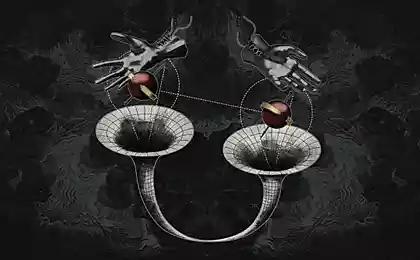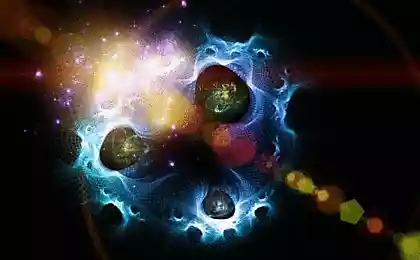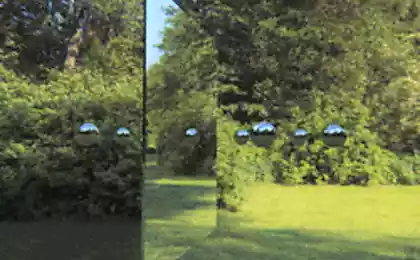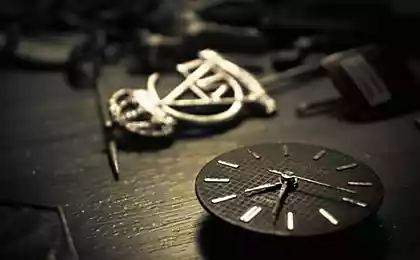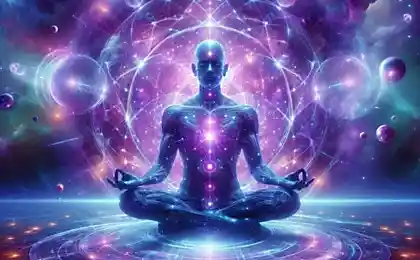476
What could be the space-time
One of the strangest aspects of quantum mechanics is entanglement as two entangled particles influence each other across vast distances that, at first glance, it violates the fundamental physical principle of locality: what happens in a certain point in space, can only affect points nearby. But what if the locality and the space itself is not so fundamental, after all? George Musser explores the possible consequences of this in his new book, "Spooky Action At a Distance". ("Spooky action at a distance" quantum entanglement called albert Einstein).
When the philosopher Jennan Ismael was ten years old, her father, a native of Iraq, Professor of the University of calgary, bought a large wooden wardrobe at auction. Rummaging in it, she came across an old kaleidoscope and was delighted. She experimented with him for hours and figured out how it works. "I told my sister that I found it because I was afraid that she'll take," she recalls.
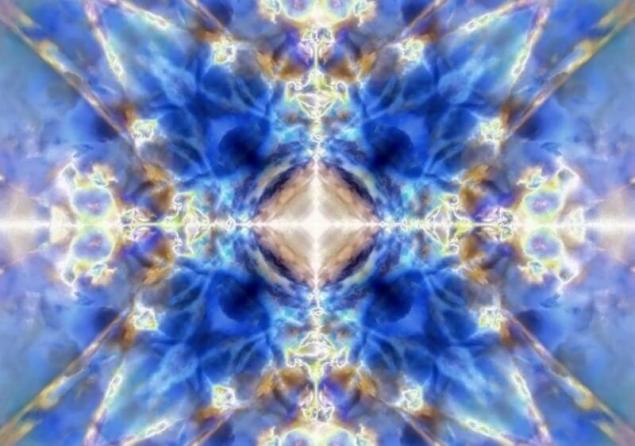
When you look into a kaleidoscope and turn the pipe, colored shapes begin to blossom, spin and unite the seemingly inexplicable and unpredictable ways, as if they had each other spooky action at a distance. But the more you admire them, the more you notice patterns in their movement. Forms on opposite ends of your field of vision are changing in unison, and this symmetry allows you to understand what is really going on: these forms are not physical objects, and image objects — pieces of glass, which rotated inside a mirrored tube.
"There is one piece of glass, which appears redundantly in different parts of the space, says Ismael. — If you focus on the General covering space, the physical description of three-dimensional kaleidoscope is pretty straightforward causal story. There is a piece of glass, it is reflected in mirrors, and so forth." Seen in reality, the kaleidoscope no longer a mystery, although still surprising.
A few decades later, preparing for a speech about quantum physics, Ismael recalled the kaleidoscope and bought a brand new, shiny copper pipe in a velvet case. He became, as it dawned on her, the metaphor of nonlocality in physics. Perhaps the particles in experiments with entanglement or galaxies in the distant galactic limits behave strangely because they are projections — secondary creations, in a way — existing in a completely different field objects.
"In the case of kaleidoscope, we know we must do: we must see the whole system; we need to see how to create the image of the space, says Ismael. — How to build an analogue of this for quantum effects? For this you need to see the space we know — a casual space in which we measure events, located in different parts of the cosmos as an unbroken structure. Perhaps when we look at the two parts, we see the same event. We interact with the same element of the reality in different parts of the space."Together with others, it casts doubt on the assumption, which should be almost every physicist and philosopher since the time of Democritus, space is the deepest level of physical reality. Just as the script of the play describes the actions of the actors on the stage, but precedes the stage, the laws of physics have traditionally accepted the existence of space for granted. Today we know that the universe is more than just things are located in space. The phenomenon of nonlocality jumps space; there's no place, wherever it was limited. It manifests itself on the level of reality deeper space, where there's no matter the concept of distance, where far things are seemingly close, as if one and the same thing appears in more than one place, like numerous images of the same piece of glass in a kaleidoscope.
When we think about the terms at this level, the relationship between the subatomic particles on a laboratory table, inside and outside the black hole and between the opposite parts of the universe no longer seems so terrible. Michael Heller, a physicist, philosopher and theologian of the Pontifical Academy of theology in Krakow, Poland, says: "If you will agree that at a fundamental level physics is non-local, everything is quite natural, because two particles that are far away from each other, are on one fundamental non-local level. For them space and time don't matter." Only when you are trying to visualize these phenomena from the position of space — which is forgivable, since we are accustomed to think — they confuse our understanding.
The idea of a deep level seems natural because, in the end, physics always sought it. Whenever they could not understand some aspects of our world, they assumed that until I got to the bottom of it all. They approached and saw the building blocks. The fact that liquid water can boil or freeze, partly mysterious. But these changes make sense, if you think of liquid, gaseous and solid state is not an elementary substance, but different forms of one fundamental substance.
Aristotle considered the different States of water in different incarnations of the so-called primary matter, and atomistic — vision — thought that atoms are rearranged in a more rigid or loose structure. En masse, these building blocks of matter acquire properties that individually they lack. Similarly, the space may consist of parts that themselves are not spatial. These parts can also understand and re-grouped into non-spatial structures such as those that hint at black holes and the Big Bang.
"Space-time cannot be fundamental, — says theorist NIMA Arkani-Hamed. — It must consist of something more simple."
This way of thinking completely reverses physics. Non-locality is no longer a mystery; it is a reality, the real mystery becomes the locality. When we can no longer take space for granted, we have to explain what it is and what occurs on their own or in the process of merging with time.
Obviously, the building space will not be as simple as the merging of the molecules in the liquid. What could be its building blocks? We usually say that the building blocks should be less things that consist of them. If you collect detailed Eiffel tower out of toothpicks, you don't have to explain that the toothpicks smaller tower.
But when it comes to space, there is no "less" because the size itself is a spatial concept. Building blocks are preceded by a space, if it is to explain them. They should not be the size or location; they need to be everywhere, across the universe and nowhere at the same time, so they would not poke. What things would mean the lack of position? Where would she be? "When we talk about deriving space-time, it must emerge from some part of which we are very far," says Arkani-Hamed.
In Western philosophy the realm beyond the space traditionally regarded as a realm outside of physics — a place of God's presence in Christian theology. In the early 18th century "monads" of Gottfried Leibniz which he represented primitive elements of the universe — existed, like God, outside of space and time. His theory was a step in the direction of the emergent space-time, but remained in the field of metaphysics, being loosely linked with the world of concrete things. If physicists succeed in explaining the emerging space, they will have to develop its own concept of lack of space.
Einstein foresaw these difficulties. "Maybe... we should give, in principle, from the space-time continuum, he wrote. — It is possible to imagine that human ingenuity will one day find methods that will make this path possible. Currently, however, such a program looks like an attempt to breathe in empty space."
John Wheeler, a famous theorist of gravity, suggested that space-time is constructed from "pregeometry", but admitted that it was just an "idea for idea". Even Arkani-Hamed shares his doubts: "These issues are very complicated. Discuss their usual language is impossible."
What makes Arkani-Hamed and his colleagues to continue, so this discovery kind of ways that were described by Einstein — ways to describe the physics there is no space to breathe in a vacuum. He explains these attempts from the point of view of history: "2000 years of people asking questions about the deep nature of space and time, but they were premature. We finally arrived in an era where you can ask these questions and hope to get some meaningful answers." published
Author: Ilya Hel
P. S. And remember, only by changing their consumption — together we change the world! ©
Join us in Facebook , Vkontakte, Odnoklassniki
Source: hi-news.ru/research-development/iz-chego-moglo-by-sostoyat-prostranstvo-vremya.html
When the philosopher Jennan Ismael was ten years old, her father, a native of Iraq, Professor of the University of calgary, bought a large wooden wardrobe at auction. Rummaging in it, she came across an old kaleidoscope and was delighted. She experimented with him for hours and figured out how it works. "I told my sister that I found it because I was afraid that she'll take," she recalls.

When you look into a kaleidoscope and turn the pipe, colored shapes begin to blossom, spin and unite the seemingly inexplicable and unpredictable ways, as if they had each other spooky action at a distance. But the more you admire them, the more you notice patterns in their movement. Forms on opposite ends of your field of vision are changing in unison, and this symmetry allows you to understand what is really going on: these forms are not physical objects, and image objects — pieces of glass, which rotated inside a mirrored tube.
"There is one piece of glass, which appears redundantly in different parts of the space, says Ismael. — If you focus on the General covering space, the physical description of three-dimensional kaleidoscope is pretty straightforward causal story. There is a piece of glass, it is reflected in mirrors, and so forth." Seen in reality, the kaleidoscope no longer a mystery, although still surprising.
A few decades later, preparing for a speech about quantum physics, Ismael recalled the kaleidoscope and bought a brand new, shiny copper pipe in a velvet case. He became, as it dawned on her, the metaphor of nonlocality in physics. Perhaps the particles in experiments with entanglement or galaxies in the distant galactic limits behave strangely because they are projections — secondary creations, in a way — existing in a completely different field objects.
"In the case of kaleidoscope, we know we must do: we must see the whole system; we need to see how to create the image of the space, says Ismael. — How to build an analogue of this for quantum effects? For this you need to see the space we know — a casual space in which we measure events, located in different parts of the cosmos as an unbroken structure. Perhaps when we look at the two parts, we see the same event. We interact with the same element of the reality in different parts of the space."Together with others, it casts doubt on the assumption, which should be almost every physicist and philosopher since the time of Democritus, space is the deepest level of physical reality. Just as the script of the play describes the actions of the actors on the stage, but precedes the stage, the laws of physics have traditionally accepted the existence of space for granted. Today we know that the universe is more than just things are located in space. The phenomenon of nonlocality jumps space; there's no place, wherever it was limited. It manifests itself on the level of reality deeper space, where there's no matter the concept of distance, where far things are seemingly close, as if one and the same thing appears in more than one place, like numerous images of the same piece of glass in a kaleidoscope.
When we think about the terms at this level, the relationship between the subatomic particles on a laboratory table, inside and outside the black hole and between the opposite parts of the universe no longer seems so terrible. Michael Heller, a physicist, philosopher and theologian of the Pontifical Academy of theology in Krakow, Poland, says: "If you will agree that at a fundamental level physics is non-local, everything is quite natural, because two particles that are far away from each other, are on one fundamental non-local level. For them space and time don't matter." Only when you are trying to visualize these phenomena from the position of space — which is forgivable, since we are accustomed to think — they confuse our understanding.
The idea of a deep level seems natural because, in the end, physics always sought it. Whenever they could not understand some aspects of our world, they assumed that until I got to the bottom of it all. They approached and saw the building blocks. The fact that liquid water can boil or freeze, partly mysterious. But these changes make sense, if you think of liquid, gaseous and solid state is not an elementary substance, but different forms of one fundamental substance.
Aristotle considered the different States of water in different incarnations of the so-called primary matter, and atomistic — vision — thought that atoms are rearranged in a more rigid or loose structure. En masse, these building blocks of matter acquire properties that individually they lack. Similarly, the space may consist of parts that themselves are not spatial. These parts can also understand and re-grouped into non-spatial structures such as those that hint at black holes and the Big Bang.
"Space-time cannot be fundamental, — says theorist NIMA Arkani-Hamed. — It must consist of something more simple."
This way of thinking completely reverses physics. Non-locality is no longer a mystery; it is a reality, the real mystery becomes the locality. When we can no longer take space for granted, we have to explain what it is and what occurs on their own or in the process of merging with time.
Obviously, the building space will not be as simple as the merging of the molecules in the liquid. What could be its building blocks? We usually say that the building blocks should be less things that consist of them. If you collect detailed Eiffel tower out of toothpicks, you don't have to explain that the toothpicks smaller tower.
But when it comes to space, there is no "less" because the size itself is a spatial concept. Building blocks are preceded by a space, if it is to explain them. They should not be the size or location; they need to be everywhere, across the universe and nowhere at the same time, so they would not poke. What things would mean the lack of position? Where would she be? "When we talk about deriving space-time, it must emerge from some part of which we are very far," says Arkani-Hamed.
In Western philosophy the realm beyond the space traditionally regarded as a realm outside of physics — a place of God's presence in Christian theology. In the early 18th century "monads" of Gottfried Leibniz which he represented primitive elements of the universe — existed, like God, outside of space and time. His theory was a step in the direction of the emergent space-time, but remained in the field of metaphysics, being loosely linked with the world of concrete things. If physicists succeed in explaining the emerging space, they will have to develop its own concept of lack of space.
Einstein foresaw these difficulties. "Maybe... we should give, in principle, from the space-time continuum, he wrote. — It is possible to imagine that human ingenuity will one day find methods that will make this path possible. Currently, however, such a program looks like an attempt to breathe in empty space."
John Wheeler, a famous theorist of gravity, suggested that space-time is constructed from "pregeometry", but admitted that it was just an "idea for idea". Even Arkani-Hamed shares his doubts: "These issues are very complicated. Discuss their usual language is impossible."
What makes Arkani-Hamed and his colleagues to continue, so this discovery kind of ways that were described by Einstein — ways to describe the physics there is no space to breathe in a vacuum. He explains these attempts from the point of view of history: "2000 years of people asking questions about the deep nature of space and time, but they were premature. We finally arrived in an era where you can ask these questions and hope to get some meaningful answers." published
Author: Ilya Hel
P. S. And remember, only by changing their consumption — together we change the world! ©
Join us in Facebook , Vkontakte, Odnoklassniki
Source: hi-news.ru/research-development/iz-chego-moglo-by-sostoyat-prostranstvo-vremya.html




